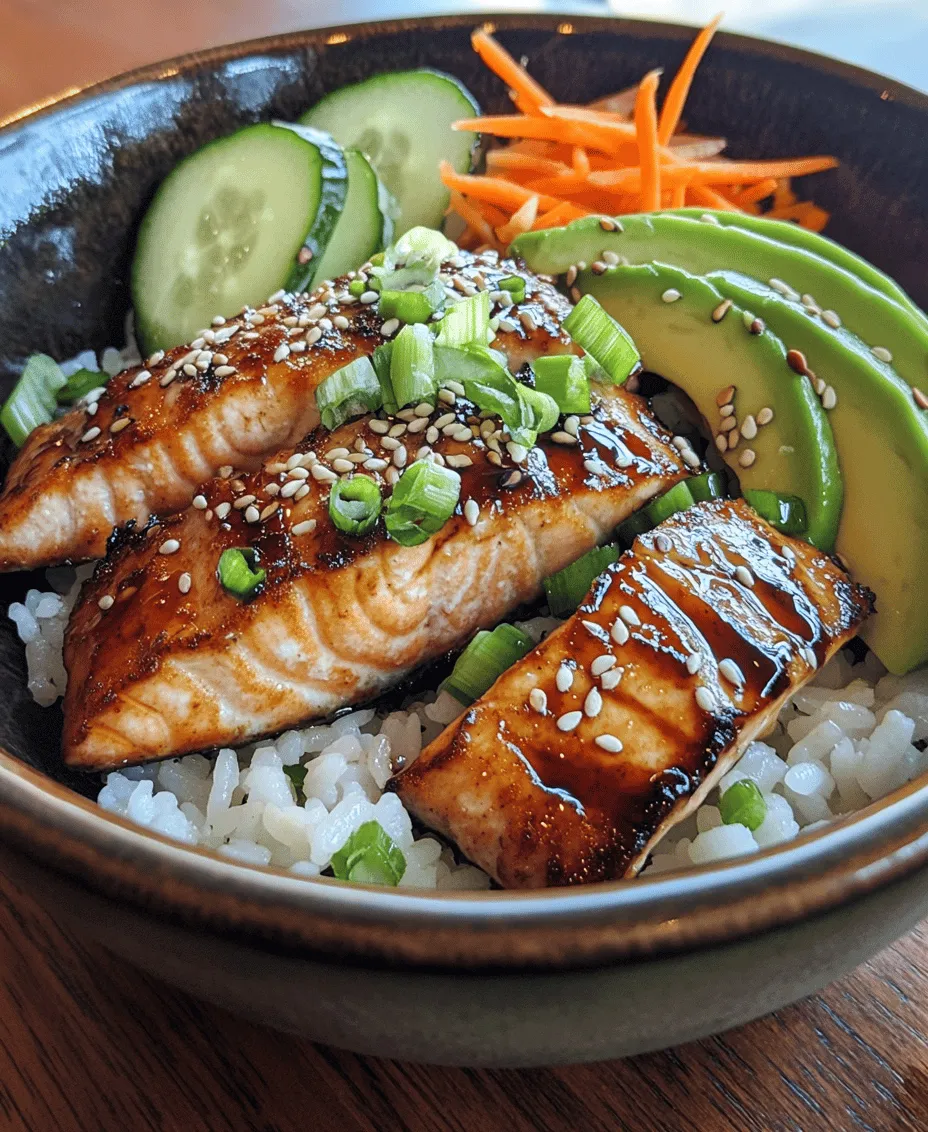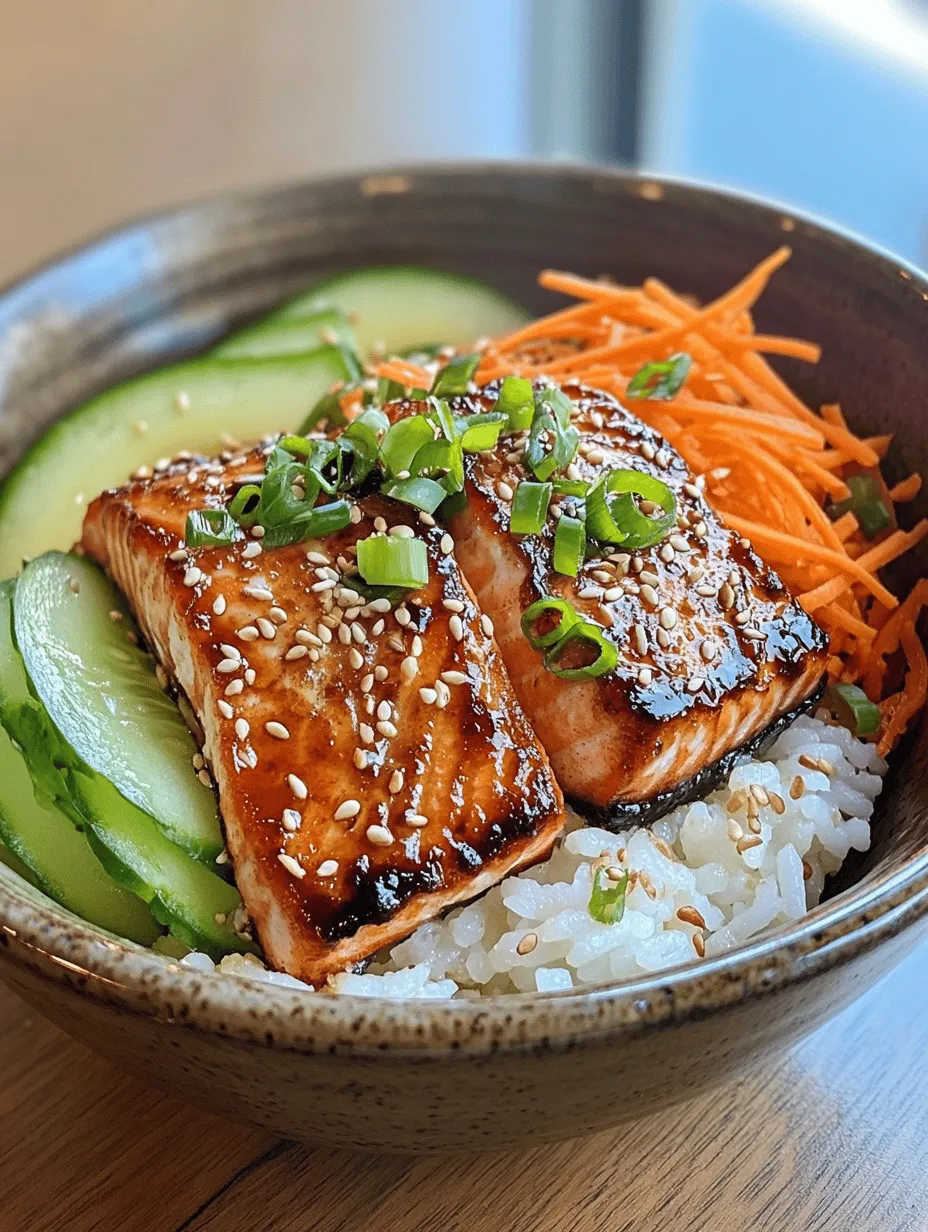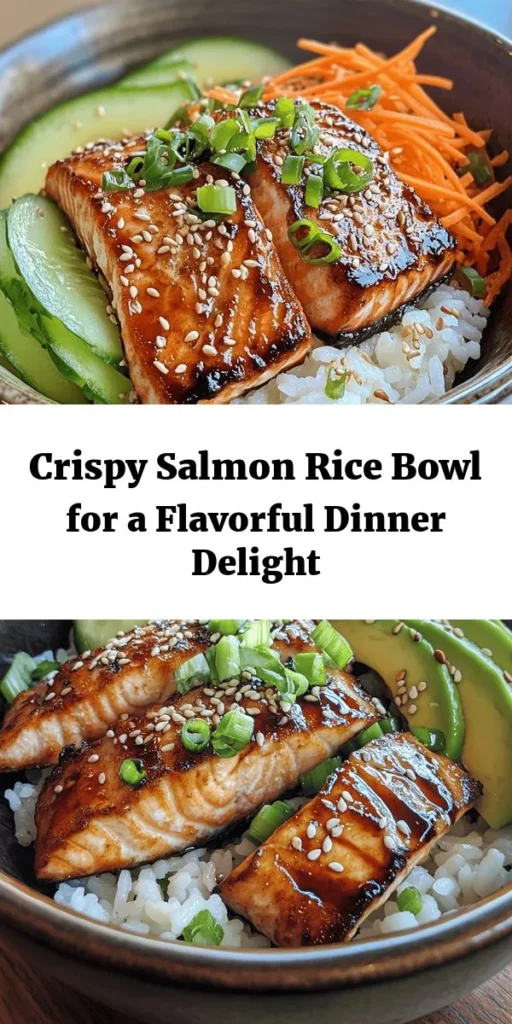Introduction
Crispy Salmon and Rice Bowl is not just a meal; it’s an experience that combines the richness of salmon with the comforting embrace of perfectly cooked sushi rice. This dish has gained popularity in recent years, becoming a staple in many homes due to its vibrant flavors, nutritional benefits, and visual appeal. With its combination of textures—from the crispy exterior of the salmon to the creamy softness of avocado—this bowl is as pleasing to the palate as it is to the eyes.
Salmon is often hailed as a superfood, packed with omega-3 fatty acids, high-quality protein, and essential vitamins. This makes the Crispy Salmon and Rice Bowl a guilt-free choice whether you’re looking to indulge or maintain healthy eating habits. The sushi rice provides a hearty base that complements the salmon beautifully, while fresh vegetables like cucumber and carrot add a refreshing crunch.
In this guide, we’ll take you through the intricacies of creating this delightful dish, ensuring it’s approachable for both seasoned chefs and kitchen novices alike. We’ll delve into each step, from understanding the key ingredients to preparing the sushi rice and marinating the salmon. By the end of this article, you’ll be equipped with everything you need to create a delicious Crispy Salmon and Rice Bowl that will impress everyone at your dinner table.
Understanding the Ingredients
Overview of Salmon and Its Health Benefits
Salmon is often regarded as one of the healthiest fish options available, and for good reason. Rich in omega-3 fatty acids, it supports heart health, reduces inflammation, and may even boost brain function. Additionally, salmon is a great source of high-quality protein, which is essential for muscle growth and repair. The fish also contains essential vitamins and minerals, including vitamin D, vitamin B12, and selenium, all of which contribute to overall health.
When selecting salmon for your Crispy Salmon and Rice Bowl, opt for fresh fillets that have a vibrant color and a mild scent. Wild-caught salmon is often preferred due to its superior flavor and higher omega-3 content compared to farmed varieties. With its health benefits and rich flavor, salmon serves as the star of this dish.
Importance of Sushi Rice and Its Texture
Sushi rice, or “shari,” is a specially prepared short-grain rice that is sticky and slightly sweet, making it the perfect base for our bowl. Its unique texture allows it to hold together while still being fluffy and light. The stickiness of sushi rice is crucial, as it helps the rice adhere to the other ingredients, creating a cohesive dish.
When cooking sushi rice, it’s important to use the right type of rice, typically labeled as “sushi rice” or “short-grain rice.” This type of rice has a higher starch content, which contributes to its stickiness. Additionally, cooking sushi rice involves rinsing it thoroughly before cooking to remove excess starch, ensuring the final product is not overly gummy.
Role of Soy Sauce, Mirin, and Sesame Oil in Flavor Enhancement
In a Crispy Salmon and Rice Bowl, the flavors of the salmon and rice are beautifully complemented by a few key condiments. Soy sauce, mirin, and sesame oil come together to create a marinade that enhances the salmon’s natural taste.
– Soy Sauce: This savory sauce adds umami flavor and depth to the dish, balancing the richness of the salmon.
– Mirin: A sweet rice wine, mirin adds a touch of sweetness and acidity, which helps to round out the flavors of the marinade.
– Sesame Oil: With its nutty aroma, sesame oil contributes a unique flavor profile that elevates the entire dish.
Together, these ingredients create a marinade that infuses the salmon with rich flavors, making each bite deliciously satisfying.
Nutritional Benefits of Avocado, Cucumber, and Carrot
While the salmon and rice are the stars of the show, the accompanying vegetables are equally important for both flavor and nutrition. Fresh ingredients like avocado, cucumber, and carrot not only enhance the dish’s visual appeal but also pack a nutritional punch.
– Avocado: Creamy and rich, avocado is loaded with healthy fats, particularly monounsaturated fats, which are beneficial for heart health. It also adds a luxurious texture to the bowl.
– Cucumber: Crisp and refreshing, cucumber provides hydration and a satisfying crunch. It’s low in calories and packed with vitamins and minerals.
– Carrot: Sweet and vibrant, shredded carrot adds color and provides essential nutrients like beta-carotene, which is vital for eye health.
Incorporating these vegetables into your bowl not only boosts its nutritional value but also adds layers of flavor and texture.
The Aesthetic Value of Garnishes Like Green Onions and Sesame Seeds
A beautiful dish is often a delicious one, and garnishes play a crucial role in the presentation of the Crispy Salmon and Rice Bowl. Green onions and sesame seeds are not just for decoration; they add flavor and texture, enhancing the overall experience.
– Green Onions: Also known as scallions, green onions provide a fresh, mild onion flavor that brightens the dish. Their vibrant green color adds a pop of visual interest.
– Sesame Seeds: Sprinkling sesame seeds on top of the bowl adds a delightful crunch and nutty flavor. They also contribute to the dish’s aesthetic appeal with their delicate, white specks against the colorful ingredients.
These garnishes elevate the presentation of your Crispy Salmon and Rice Bowl, making it a feast for the eyes as well as the taste buds.
Preparing the Sushi Rice
Creating the perfect sushi rice is a crucial step in achieving a delicious Crispy Salmon and Rice Bowl. Here’s a step-by-step guide to preparing sushi rice that is fluffy, sticky, and full of flavor.
Rinsing the Rice: Importance of Removing Excess Starch
Before cooking your sushi rice, it is essential to rinse it thoroughly. Rinsing removes excess starch that can cause the rice to become gummy and sticky. To rinse the rice, place it in a fine-mesh strainer or a bowl and cover it with cold water. Gently swirl the rice with your fingers, allowing the water to become cloudy. Drain the water and repeat this process several times until the water runs clear, indicating that most of the excess starch has been removed.
Cooking Techniques: Boiling and Simmering for Optimal Texture
Once the rice has been rinsed, it’s time to cook it. The cooking process is straightforward but requires attention to detail for the best results.
1. Measure the Rice: Use a measuring cup to portion the desired amount of sushi rice. A typical serving is about 1 cup of uncooked rice for two servings.
2. Combine with Water: Add the rinsed rice to a rice cooker or a saucepan and combine it with water. The general ratio is 1 cup of rice to 1.25 cups of water.
3. Cooking: If using a rice cooker, simply turn it on and let it do the work. If cooking on the stove, bring the water to a boil over high heat, then reduce the heat to low, cover the pot, and allow it to simmer for about 15 minutes. Do not lift the lid during this time, as it allows steam to escape.
4. Resting: Once the rice has absorbed all the water, remove it from heat and let it sit, covered, for an additional 10 minutes. This resting period allows the rice to finish cooking and become tender.
Fluffing the Rice: Ensuring a Light and Airy Finish
After resting, it’s time to fluff the rice. Using a wooden spoon or a rice paddle, gently stir the rice to separate the grains. Be careful not to mash or crush the rice, as you want to maintain its fluffy texture.
Tips for Storing Leftover Rice or Using It in Other Dishes
If you have leftover sushi rice, store it in an airtight container in the refrigerator. Sushi rice can be used in various dishes such as sushi rolls, rice balls, or even as a base for grain bowls. When reheating, add a splash of water and microwave until warm. This will help restore some moisture to the rice, preventing it from becoming dry.
Marinating the Salmon
Marination is a key step in enhancing the flavor of your salmon fillets. A well-balanced marinade will infuse the fish with rich flavors, making each bite of your Crispy Salmon and Rice Bowl truly irresistible.
Choosing the Right Salmon Fillets: Freshness and Quality
To start, select high-quality salmon fillets for marination. Look for fillets that are bright in color, firm to the touch, and have a mild scent. Freshness is paramount, as it greatly influences the flavor and texture of the finished dish. If possible, buy your salmon from a reputable fishmonger or grocery store that offers sustainably sourced fish.
The Marinade Mixture: Balancing Flavors with Soy Sauce, Mirin, and Sesame Oil
For the marinade, you will need the following ingredients:
– Soy Sauce: 2 tablespoons
– Mirin: 1 tablespoon
– Sesame Oil: 1 tablespoon
– Optional Additions: You can also add a touch of garlic or ginger for extra flavor.
Combine these ingredients in a small bowl and whisk them together until well mixed. The soy sauce provides umami, while the mirin contributes sweetness and acidity, and the sesame oil adds a nutty flavor.
Recommended Marinating Time for Maximum Flavor Absorption
Place the salmon fillets in a shallow dish or a resealable plastic bag and pour the marinade over the fish. Make sure the fillets are fully coated in the marinade. For optimal flavor absorption, marinate the salmon for at least 30 minutes, but you can also let it sit for up to 2 hours in the refrigerator. Just be careful not to exceed this time, as the soy sauce can begin to cure the fish, altering its texture.
Tips on Alternative Marinades or Variations
While the soy sauce, mirin, and sesame oil combination is classic, you can experiment with different marinades to suit your taste. Consider adding citrus juices, such as lemon or lime, for a refreshing twist. Alternatively, try using teriyaki sauce for a sweeter flavor or a spicy sriracha marinade for an added kick.
—
By mastering these foundational steps, you’re well on your way to creating a Crispy Salmon and Rice Bowl that is not only delicious but also visually stunning. Stay tuned for the next part where we will cover the cooking process of the salmon and the assembly of the bowl.

Techniques for Achieving Crispy Skin and Perfectly Cooked Fillets
Creating the perfect crispy salmon fillet requires attention to detail, especially when it comes to cooking techniques. Here are some essential tips to ensure your salmon has that coveted crispy skin and tender, perfectly cooked flesh.
Selecting the Right Frying Oil for Health and Flavor
Choosing the right oil is crucial for achieving the perfect crispy skin on your salmon. Opt for oils with a high smoke point, such as avocado oil or canola oil. These oils not only withstand high temperatures without burning but also impart a neutral flavor that allows the natural taste of the salmon to shine. Olive oil is another great option, particularly extra virgin, if you prefer a slightly fruity flavor. Avoid oils that have strong flavors, like sesame oil, as they can overwhelm the delicate taste of the fish.
Ideal Skillet Temperature for Cooking Salmon
Temperature control is vital when cooking salmon to ensure that the skin crisps up beautifully without overcooking the fillet. Heat your skillet over medium-high heat and add your chosen oil. The oil should shimmer but not smoke. To test if the skillet is ready, flick a few drops of water into the pan; if they sizzle and evaporate quickly, it’s time to add the salmon. Cooking at the right temperature will help achieve that golden-brown crust while keeping the inside moist and flaky.
Techniques for Flipping Salmon Without Breaking the Fillet
One of the biggest challenges when cooking salmon is flipping it without breaking the fillet. After cooking the skin side, gently lift the edge of the fillet with a spatula. If it releases easily from the pan, it’s ready to be flipped. If not, give it a little more time. Use a wide spatula to carefully turn the salmon over, which helps distribute the weight evenly and prevents it from breaking apart. If your fillet is particularly thick, consider using two spatulas to support it while flipping.
Understanding Doneness: Recognizing When the Salmon is Fully Cooked
Knowing when your salmon is perfectly cooked is essential. The best way to check for doneness is to look for a change in color and texture. The salmon should be opaque and flake easily with a fork. If you have a meat thermometer, the internal temperature should reach 125°F (51°C) for medium-rare and 145°F (63°C) for well-done. Remember that the salmon will continue to cook slightly after being removed from the heat, so it’s best to take it off just before it reaches your desired doneness.
Assembling the Rice Bowl
Once your salmon is perfectly cooked, it’s time to assemble the rice bowl. This is where you can get creative and make your dish visually appealing as well as delicious.
Layering the Rice: Importance of a Solid Base
Start by using a generous serving of rice as the base of your bowl. Sushi rice or jasmine rice works well due to their sticky texture, which helps hold the bowl together. Use a rice cooker or stovetop method to prepare the rice, ensuring you season it lightly with rice vinegar, salt, and sugar for added flavor. Fluff the rice with a fork before adding it to the bowl to keep it airy and prevent clumping.
Arranging Salmon and Vegetables: Creating an Inviting Presentation
Once the rice is ready, place the crispy salmon fillet on top, skin side up, to showcase that beautiful golden crust. Next, add your choice of vegetables around the salmon. Fresh ingredients like sliced cucumbers, shredded carrots, and edamame not only enhance the flavor but also add a pop of color. Consider arranging the vegetables in a rainbow pattern for an eye-catching display.
Using Colors and Textures to Enhance the Dish
Maximizing color and texture can elevate your rice bowl from simple to spectacular. Incorporate a variety of ingredients, such as vibrant bell peppers, bright green avocado slices, and crunchy radishes. The contrast of textures—from the crispy skin of the salmon to the creamy avocado and crunchy vegetables—creates a delightful eating experience.
Suggestions for Additional Toppings or Variations
Feel free to personalize your rice bowl with additional toppings. A drizzle of sriracha or a sprinkle of furikake can add an extra kick of flavor. For a touch of sweetness, consider adding mango slices or pickled ginger. If you’re looking for a vegetarian option, swap the salmon for tofu or tempeh, marinating and cooking them in a similar way to achieve a savory flavor profile.
Finishing Touches
To truly elevate your crispy salmon and rice bowl, add some finishing touches that enhance the flavors and presentation.
The Role of Reserved Marinade: Adding Depth to the Dish
If you reserved part of your marinade before adding the raw salmon, now is the time to utilize it. Drizzle the marinade over the assembled bowl to add depth and richness to the dish. This simple step not only enhances the flavor but also ties all the components together, making every bite more satisfying.
Garnishing with Green Onions and Sesame Seeds for a Professional Finish
For a professional touch, sprinkle chopped green onions and sesame seeds over the top of your bowl. Green onions provide a refreshing crunch, while sesame seeds add a nutty flavor and visual appeal. This finishing touch not only makes your dish look more appetizing but also adds layers of flavor that complement the salmon and vegetables perfectly.
Serving Suggestions for a Complete Meal Experience
For a complete meal experience, consider pairing your crispy salmon and rice bowl with a light miso soup or a side salad. This combination provides a well-rounded dining experience and balances the flavors of the dish, ensuring that every bite is memorable.
Health Benefits of the Crispy Salmon and Rice Bowl
This delectable dish is not just about taste; it also packs a nutritional punch. Understanding the health benefits can add to the enjoyment of your meal.
Overview of Omega-3 Fatty Acids from Salmon
Salmon is renowned for its rich content of omega-3 fatty acids, which are essential for heart health. These healthy fats help reduce inflammation, lower blood pressure, and improve overall cardiovascular function. Including salmon in your diet can also contribute to brain health, making it a fantastic choice for both body and mind.
Benefits of Fiber and Vitamins from Vegetables
The array of vegetables included in your rice bowl provides a wealth of fiber, vitamins, and minerals. Fiber aids in digestion, while vitamins like A, C, and K support your immune system and overall health. Incorporating a variety of colors in your vegetables ensures you receive a broad spectrum of nutrients, making your meal not only delicious but also nutritious.
Balanced Meal: Protein, Carbs, and Healthy Fats
The crispy salmon and rice bowl is a well-balanced meal that includes protein from the salmon, carbohydrates from the rice, and healthy fats from both the fish and any added toppings. This combination helps keep you satiated and provides sustained energy throughout the day. It’s an excellent option for those looking to maintain a healthy lifestyle without sacrificing flavor.
Conclusion
The Crispy Salmon and Rice Bowl is not just a meal; it’s an experience that brings together flavor, nutrition, and creativity. By following this comprehensive guide, you can master the art of making this delectable dish at home. The combination of crispy salmon, fluffy rice, and fresh vegetables creates a satisfying and healthy option that is sure to impress your family and friends. Embrace the joy of cooking and enjoy the wonderful flavors that this bowl has to offer. With each bite, you will appreciate the depth of flavors and the health benefits that come from this beautifully crafted dish. Enjoy your culinary journey!



